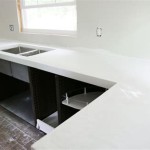How to Lime Wash Oak Cabinets
Lime washing is a popular technique for creating a light, airy, and slightly distressed look on cabinetry. It's particularly well-suited for oak cabinets, whose natural grain can be beautifully highlighted by the translucent nature of limewash. The process is relatively straightforward and can be achieved with minimal tools and materials. However, it's important to follow the correct steps to ensure a successful outcome.
Preparing the Cabinets
Before applying limewash, it's crucial to prepare the oak cabinets properly. This involves cleaning, sanding, and priming, which lay the foundation for a smooth and even finish. Begin by thoroughly cleaning the cabinets with a mild detergent and water. Pay attention to any sticky residues or grease buildup, as limewash won't adhere well to these surfaces. Once clean, allow the cabinets to dry completely. Next, lightly sand the cabinets with fine-grit sandpaper to remove any imperfections and create a smooth surface for the limewash. This step also helps the limewash adhere better. Finally, apply a primer specifically designed for limewash. This primer ensures that the limewash adheres evenly and prevents staining from the oak wood.
Applying the Limewash
Limewash is typically applied in thin coats using a brush or roller. The application process requires a light touch and even strokes. Begin by mixing the limewash according to the manufacturer's instructions. Some lime washes require specific dilution ratios, while others come pre-mixed. It's always advisable to test the limewash on a small, inconspicuous area first to ensure the desired color and consistency. Apply the limewash in thin, even coats, working in the direction of the wood grain. Allow each coat to dry completely before applying the next. Depending on the desired opacity, you may need to apply several coats. Be mindful of avoiding streaks or uneven coverage by maintaining a consistent application pattern.
Finishing Touches
Once the limewash has dried, you can apply a sealant to protect the finish. This step is important for durability and helps prevent the limewash from fading or becoming discolored. Apply a sealant specifically formulated for limewash, following the manufacturer's instructions. Be sure to allow the sealant to dry completely before using the cabinets. You may also want to consider adding a protective coating to the countertop if it is made of a natural stone like granite or marble. This will protect it from spills and stains.
Additional Tips
For a more distressed look, consider using a damp cloth to gently rub the limewash once it has dried. This will create subtle areas of wear and tear, enhancing the aged appearance. Additionally, if you prefer a more rustic look, you can apply a glaze after the limewash has dried. This can add depth and dimension to the finish. However, avoid using a glaze if you want a minimal, modern look. As with any painting project, it's crucial to work in a well-ventilated area and wear appropriate protective gear, such as gloves and a mask, to shield yourself from the potential irritants in limewash.

Limed Oak Cabinet Kitchens

Limed Oak Cabinet Kitchens

Liming Wax On Oak Cabinets

Limed Oak Cabinet Kitchens

Limed Oak Kitchen A Solid Mark Erfield Furniture

Cerused French Oak Kitchens And Cabinets Kitchen Trend 2024 Petite Haus

Diy Lime Wax On Honey Oak Cabinets

Liming Wax On Oak Cabinets

How To Get A Rustic Bleached Wood Finish House Mix

Briwax Before And After
Related Posts








